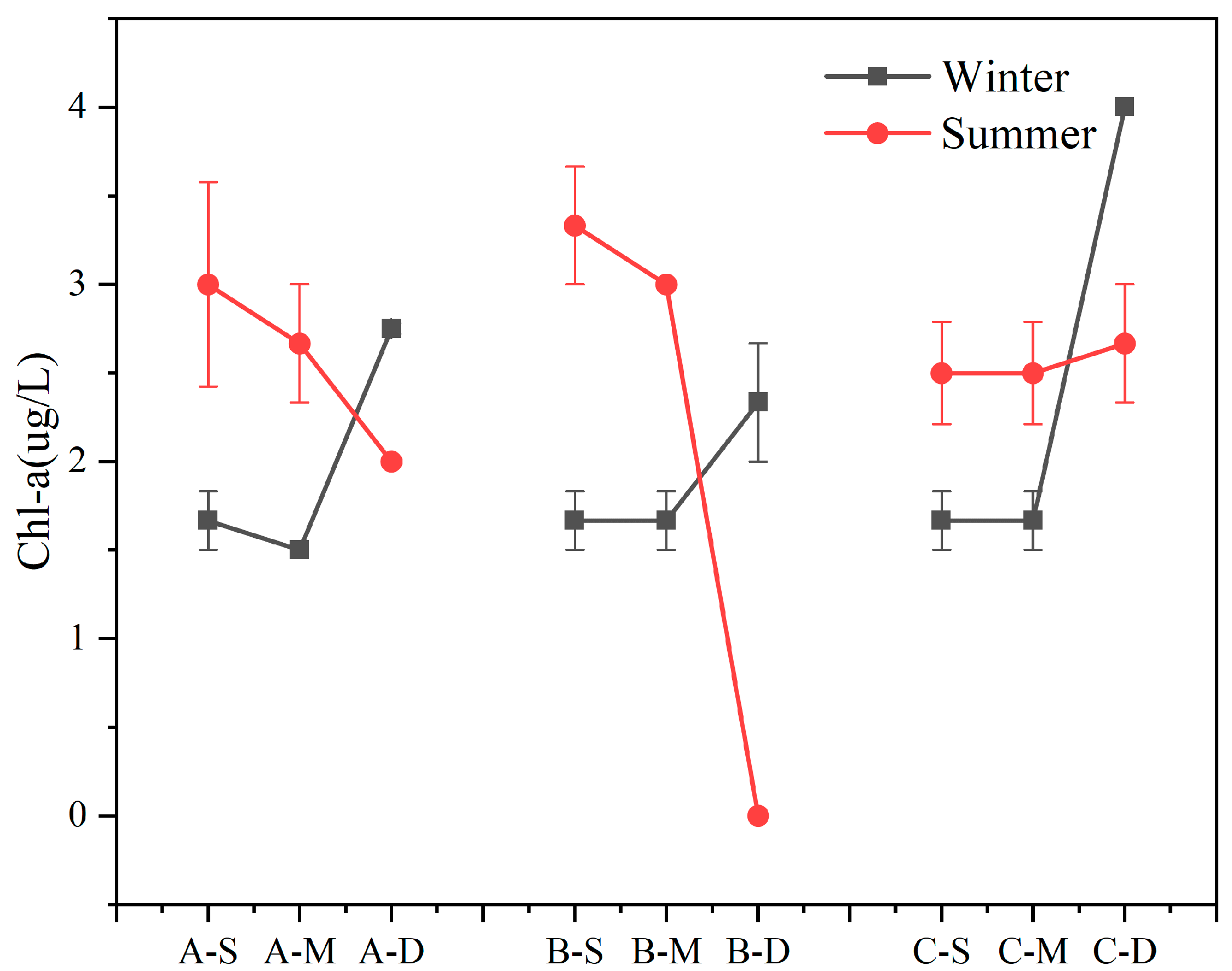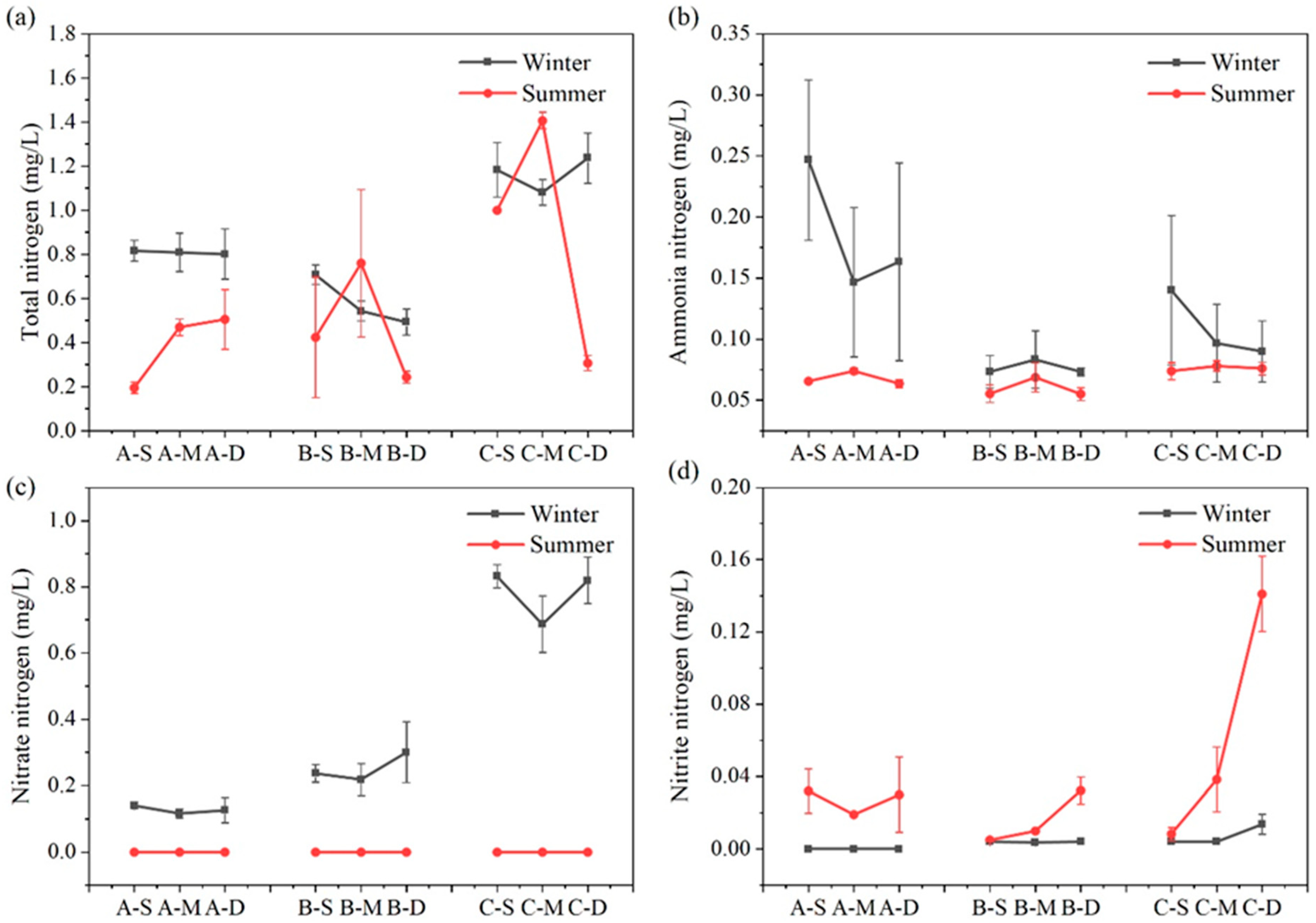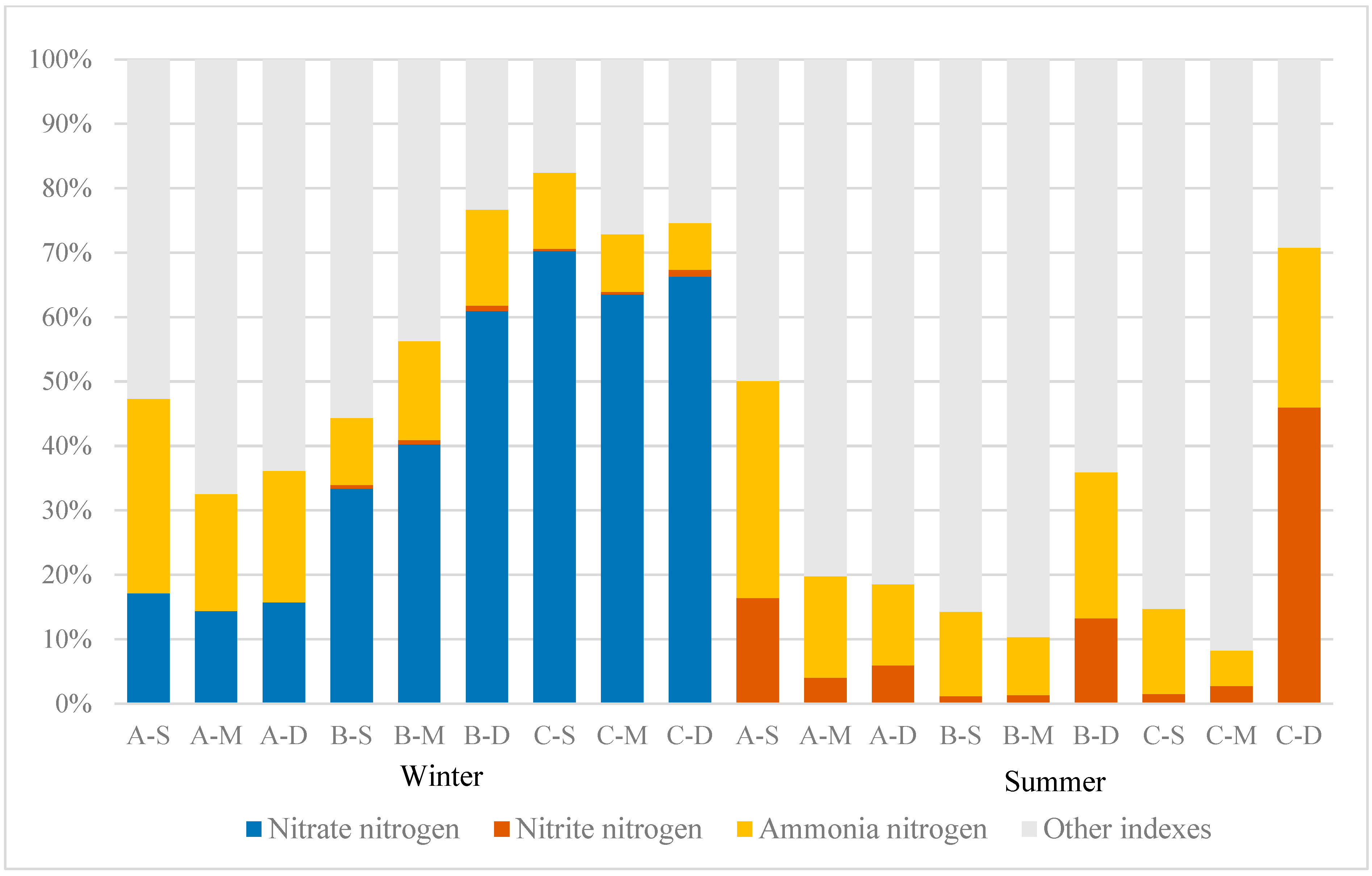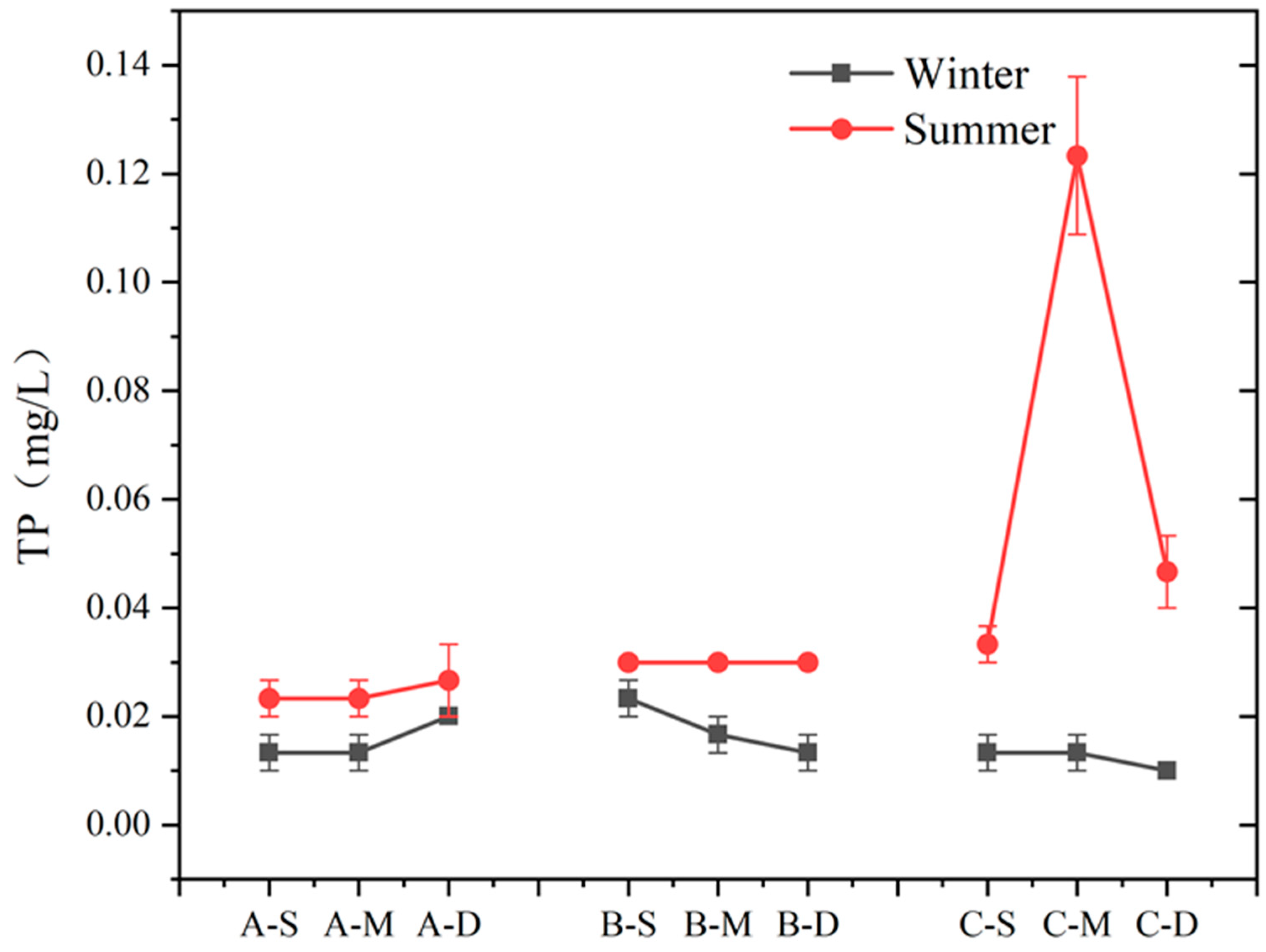Seasonal Effects of Constructed Wetlands on Water Quality Characteristics in Jinshan Lake: A Gate Dam Lake (Zhenjiang City, China)
Abstract
Simple Summary
Abstract
1. Introduction
2. Materials and Methods
2.1. Site Description
2.2. Sample Analysis and Data Processing
2.3. Water Quality Evaluation Methods
3. Results
3.1. Chlorophyll a
3.2. Biochemical Oxygen Demand after 5 Days
3.3. Nitrogen
3.4. Distribution of N Content and Proportion of Each Form
3.5. Phosphorus
3.6. Correlation Analysis
3.7. Water Quality
4. Discussion
4.1. Seasonal Variations in the Main Pollutants of Water (N and P) and the Function of Constructed Wetlands
4.2. Analysis of Other Water Environment Quality Characteristic Indexes and Their Internal Relations
4.3. Limitations and Future Development
5. Conclusions
- (1)
- Constructed wetlands significantly enhance TN removal during summer but only have a certain effect on nitrate–nitrogen removal in winter. However, they play a minor role in TP removal and even become a potential P source for lakes in winter due to the decomposition of wetland plant residues into sediments, threatening water quality safety;
- (2)
- The seasonal variations in lake water environmental indicators are readily apparent. During winter, N, predominantly as nitrate–nitrogen, interacts with BOD5, emerging as the primary factor collectively constraining lake water quality. During summer, TP assumes the primary role as the constraining factor of water quality. As an intermediate product in the N cycle’s redox pathway, the accumulation of nitrite–nitrogen correlates with water temperature across varying seasons. Nitrite–nitrogen accumulation will rise with increasing water temperatures in summer, whereas the converse holds true in winter;
- (3)
- Chl-a concentrations are higher under conditions of sufficient light and suitable temperature. Concurrently, the biomass present in the surface water layer and microbial biomass at the water–sediment interface exert substantial influence on ammonia–nitrogen removal efficiency via assimilation and nitrification within constructed wetlands. Moreover, surface water illumination damages ammonia oxidase, reducing the content of nitrite–nitrogen.
Author Contributions
Funding
Institutional Review Board Statement
Informed Consent Statement
Data Availability Statement
Acknowledgments
Conflicts of Interest
Abbreviations
References
- Schallenberg, M.; Winton, M.D.; Verburg, P.; Kelly, D.; Hamill, K.; Hamilton, D. Ecosystem Services of Lakes. In Ecosystem Services in New Zealand: Conditions and Trends; Manaaki Whenua Press: Lincoln, UK, 2013; pp. 203–225. [Google Scholar]
- Zhang, Y.; Qin, B.; Zhu, G.; Song, C.; Deng, J.; Xue, B.; Gong, Z.; Wang, X.; Wu, J.; Shi, K.; et al. Importance and Main Ecological and Environmental Problems of Lakes in China. Chin. Sci. Bull. 2022, 67, 3503–3519. [Google Scholar] [CrossRef]
- Song, C.; Jiang, X.; Fan, C.; Li, L. High-Resolution circa-2020 Map of Urban Lakes in China. Sci. Data 2022, 9, 747. [Google Scholar] [CrossRef] [PubMed]
- Liu, H.-L.; Cheng, C.; Zuo, L.-Z.; Yan, M.-Y.; He, Y.-L.; Huang, S.; Ke, M.-J.; Guo, X.-L.; Feng, Y.; Qian, H.-F.; et al. Strain-Boosted Hyperoxic Graphene Oxide Efficiently Loading and Improving Performances of Microcystinase. iScience 2022, 25, 104611. [Google Scholar] [CrossRef] [PubMed]
- Mesmer, R. Impact of Urban Runoff on Phosphorus, Nitrogen, and Dissolved Oxygen in a Shallow Subtropical Lake. Master’s Thesis, Louisiana State University and Agricultural and Mechanical College, Baton Rouge, LA, USA, 2010. [Google Scholar]
- Cox, T.; Wolosoff, S.; Shum, C.; Nik-Khah, T. A Tale of Two Contaminants: Stark Differences in the Response of N and P to Urban Lake Mitigation Efforts. H2Open J. 2022, 5, 515–531. [Google Scholar] [CrossRef]
- Babu, K.N.; Ouseph, P.P.; Padmalal, D. Interstitial Water—Sediment Geochemistry of N, P and Fe and Its Response to Overlying Waters of Tropical Estuaries: A Case from the Southwest Coast of India. Environ. Geol. 2000, 39, 633–640. [Google Scholar] [CrossRef]
- Berelson, W.M.; Heggie, D.; Longmore, A.; Kilgore, T.; Nicholson, G.; Skyring, G. Benthic Nutrient Recycling in Port Phillip Bay, Australia. Estuar. Coast. Shelf Sci. 1998, 46, 917–934. [Google Scholar] [CrossRef]
- Ji, W.-X.; Tian, Y.-C.; Cai, M.-H.; Jiang, B.-C.; Cheng, S.; Li, Y.; Zhou, Q.; Li, B.-Q.; Chen, B.-Y.; Zheng, X.; et al. Simultaneous Determination of Dissolved Organic Nitrogen, Nitrite, Nitrate and Ammonia Using Size Exclusion Chromatography Coupled with Nitrogen Detector. J. Environ. Sci. 2023, 125, 309–318. [Google Scholar] [CrossRef] [PubMed]
- Zhang, C.; Wang, D.; He, W.; Liu, H.; Chen, J.; Wei, X.; Mu, J. Sesuvium Portulacastrum-Mediated Removal of Nitrogen and Phosphorus Affected by Sulfadiazine in Aquaculture Wastewater. Antibiotics 2022, 11, 68. [Google Scholar] [CrossRef] [PubMed]
- Qu, S.; Wang, J.; Kumar, A.; Yu, Z.-G.; Zhao, W.-Q. Identification of Driving Factors for Chlorophyll-a in Multi-Stable Shallow Lakes of China Employing Machine Learning Methods. Ecohydrology 2023, 16, e2590. [Google Scholar] [CrossRef]
- Sun, Q.; Yue, F.; Chen, J.; Wang, J.; Li, Y.; Li, X.; Bhat, M.A.; Liu, J.; Li, S. Nitrogen and Phosphorus Diffusion Fluxes: Insight from High-Resolution Technology and Hydrodynamic Modeling. Water 2021, 13, 3232. [Google Scholar] [CrossRef]
- Nakagiri, A.; Mutyaba, A.; Onyutha, C.; Okurut, K. Abating Eutrophication on Urban Lakes: A Case Study of Kabaka’s Lake, Uganda. Water Pract. Technol. 2023, 18, 1970–1979. [Google Scholar] [CrossRef]
- Belete, M.D. Ecohydrology to Harmonize Industrialization and Ecological Safety in Urban Environment: Case of Hawassa Lake, Industries and Cheleleka Wetland. Ecohydrol. Hydrobiol. 2018, 18, 192–200. [Google Scholar] [CrossRef]
- Deng, J.; Guo, L.; Salas, W.; Ingraham, P.; Charrier-Klobas, J.G.; Frolking, S.; Li, C. A Decreasing Trend of Nitrous Oxide Emissions From California Cropland From 2000 to 2015. Earths Future 2022, 10, e2021EF002526. [Google Scholar] [CrossRef] [PubMed]
- Karstens, S.; Buczko, U.; Glatzel, S. Phosphorus Storage and Mobilization in Coastal Phragmites Wetlands: Influence of Local-Scale Hydrodynamics. Estuar. Coast. Shelf Sci. 2015, 164, 124–133. [Google Scholar] [CrossRef]
- Peng, Z.; Du, Y.; Niu, S.; Xi, L.; Niu, Y.; Li, Y. Differences in Nitrogen and Phosphorus Sinks between the Harvest and Non-Harvest of Miscanthus Lutarioriparius in the Dongting Lake Wetlands. Front. Plant Sci. 2022, 13, 989931. [Google Scholar] [CrossRef]
- Binh, N.T.; Anh, B.T.K.; Thanh, N.V.; Kim, D.D.; Phuong, N.M. The Influence of Pollutants on Plant Growth and Treatment Efficiency of Horizontally-Constructed Wetlands. Vietnam. J. Sci. Technol. Eng. 2023, 65, 42–46. [Google Scholar] [CrossRef]
- Li, D.; Zheng, B.; Chu, Z.; Liu, Y.; Huang, M. Seasonal Variations of Performance and Operation in Field-Scale Storing Multipond Constructed Wetlands for Nonpoint Source Pollution Mitigation in a Plateau Lake Basin. Bioresour. Technol. 2019, 280, 295–302. [Google Scholar] [CrossRef] [PubMed]
- Pu, Y.; Li, Y.; Zhu, L.; Cheng, Y.; Nuamah, L.A.; Zhang, H.; Chen, H.; Du, G.; Wang, L.; Song, C. Long-Term Assessment on Performance and Seasonal Optimal Operation of a Full-Scale Integrated Multiple Constructed Wetland-Pond System. Sci. Total Environ. 2023, 862, 161219. [Google Scholar] [CrossRef]
- Zhong, J.; Yu, J.; Wang, J.; Liu, D.; Chen, C.; Fan, C. The Co-Regulation of Nitrate and Temperature on Denitrification at the Sediment-Water Interface in the Algae-Dominated Ecosystem of Lake Taihu, China. J. Soils Sediments 2020, 20, 2277–2288. [Google Scholar] [CrossRef]
- Guo, C.; Cui, Y.; Shi, Y.; Luo, Y.; Liu, F.; Wan, D.; Ma, Z. Improved Test to Determine Design Parameters for Optimization of Free Surface Flow Constructed Wetlands. Bioresour. Technol. 2019, 280, 199–212. [Google Scholar] [CrossRef]
- Jóźwiakowski, K.; Bugajski, P.; Kurek, K.; Cáceres, R.; Siwiec, T.; Jucherski, A.; Czekała, W.; Kozłowski, K. Technological Reliability of Pollutant Removal in Different Seasons in One-Stage Constructed Wetland System with Horizontal Flow Operating in the Moderate Climate. Sep. Purif. Technol. 2020, 238, 116439. [Google Scholar] [CrossRef]
- Shi, X.; Yu, H.; Zhao, S.; Sun, B.; Liu, Y.; Huo, J.; Wang, S.; Wang, J.; Wu, Y.; Wang, Y.; et al. Impacts of Environmental Factors on Chlorophyll-a in Lakes in Cold and Arid Regions: A 10-Year Study of Wuliangsuhai Lake, China. Ecol. Indic. 2023, 148, 110133. [Google Scholar] [CrossRef]
- Yang, F.; Zhang, H.; Zhang, X.; Zhang, Y.; Li, J.; Jin, F.; Zhou, B. Performance Analysis and Evaluation of the 146 Rural Decentralized Wastewater Treatment Facilities Surrounding the Erhai Lake. J. Clean. Prod. 2021, 315, 128159. [Google Scholar] [CrossRef]
- Liu, Y.; Yu, J.; Sun, H.; Li, T.; He, X.; Lin, Z. Screening and Prioritizing Substances in Groundwater in the Beijing–Tianjin–Hebei Region of the North China Plain Based on Exposure and Hazard Assessments. J. Hazard. Mater. 2022, 423, 127142. [Google Scholar] [CrossRef] [PubMed]
- Chen, J.; Ying, G.-G.; Liu, Y.-S.; Wei, X.-D.; Liu, S.-S.; He, L.-Y.; Yang, Y.-Q.; Chen, F.-R. Nitrogen Removal and Its Relationship with the Nitrogen-Cycle Genes and Microorganisms in the Horizontal Subsurface Flow Constructed Wetlands with Different Design Parameters. J. Env. Sci. Health A Tox Hazard. Subst. Env. Eng. 2017, 52, 804–818. [Google Scholar] [CrossRef]
- Zeng, Y.; Chang, F.; Wen, X.; Duan, L.; Zhang, Y.; Liu, Q.; Zhang, H. Seasonal Variation in the Water Quality and Eutrophication of Lake Xingyun in Southwestern China. Water 2022, 14, 3677. [Google Scholar] [CrossRef]
- Ji, X.; Dahlgren, R.A.; Zhang, M. Comparison of Seven Water Quality Assessment Methods for the Characterization and Management of Highly Impaired River Systems. Env. Monit. Assess. 2015, 188, 15. [Google Scholar] [CrossRef] [PubMed]
- Zhou, J.; Han, X.; Brookes, J.D.; Qin, B. High Probability of Nitrogen and Phosphorus Co-Limitation Occurring in Eutrophic Lakes. Environ. Pollut. 2022, 292, 118276. [Google Scholar] [CrossRef]
- Li, N.; Tian, X.; Li, Y.; Fu, H.; Jia, X.; Jin, G.; Jiang, M. Seasonal and Spatial Variability of Water Quality and Nutrient Removal Efficiency of Restored Wetland: A Case Study in Fujin National Wetland Park, China. Chin. Geogr. Sci. 2018, 28, 1027–1037. [Google Scholar] [CrossRef]
- Chawley, P.; Yadav, K.; Jagadevan, S. Nitrogenous Wastes and Its Efficient Treatment in Wastewater. In Water Pollution and Management Practices; Singh, A., Agrawal, M., Agrawal, S.B., Eds.; Springer: Singapore, 2021; pp. 147–175. ISBN 9789811583582. [Google Scholar]
- Bayley, M.L.; Davison, L.; Headley, T.R. Nitrogen Removal from Domestic Effluent Using Subsurface Flow Constructed Wetlands: Influence of Depth, Hydraulic Residence Time and Pre-Nitrification. Water Sci. Technol. 2003, 48, 175–182. [Google Scholar] [CrossRef]
- Sun, F.; Shang, Y.; Xu, C.; Lv, Y.; Su, X.; Wang, M.; Dong, Q.; Xu, Y.; Li, M.; Yin, X. Performances of Nitrogen Removal by Constructed Wetlands with Different Plant Species and Seasons. Int. J. Environ. Sci. Technol. 2024. [Google Scholar] [CrossRef]
- Lin, K.; Zhu, Y.; Zhang, Y.; Lin, H. Determination of Ammonia Nitrogen in Natural Waters: Recent Advances and Applications. Trends Environ. Anal. Chem. 2019, 24, e00073. [Google Scholar] [CrossRef]
- Zehr, J.; Kudela, R. Nitrogen Cycle of the Open Ocean: From Genes to Ecosystems. Annu. Rev. Mar. Sci. 2011, 3, 197–225. [Google Scholar] [CrossRef] [PubMed]
- Li, X.; Li, Y.; Li, Y.; Wu, J. Enhanced Nitrogen Removal and Quantitative Analysis of Removal Mechanism in Multistage Surface Flow Constructed Wetlands for the Large-Scale Treatment of Swine Wastewater. J. Environ. Manag. 2019, 246, 575–582. [Google Scholar] [CrossRef]
- Gardner, W.S.; Lavrentyev, P.J.; Cavaletto, J.F.; McCarthy, M.J.; Eadie, B.J.; Johengen, T.H.; Cotner, J.B. Distribution and Dynamics of Nitrogen and Microbial Plankton in Southern Lake Michigan during Spring Transition 1999–2000. J. Geophys. Res. Ocean. 2004, 109, C03007. [Google Scholar] [CrossRef]
- Xue, J.; Liu, W.; Jiang, X.; Zhao, Z.; Zhang, L.; Cai, Y.; Wang, X. Ammonium Recycling and Its Influencing Factors Along the Littoral Zone of the Middle Reaches of Yangtze River. Resour. Environ. Yangtze Basin 2019, 28, 2735–2742. [Google Scholar] [CrossRef]
- Jin, Z.; Cen, J.; Hu, Y.; Li, L.; Shi, Y.; Fu, G.; Li, F. Quantifying Nitrate Sources in a Large Reservoir for Drinking Water by Using Stable Isotopes and a Bayesian Isotope Mixing Model. Environ. Sci. Pollut. Res. 2019, 26, 20364–20376. [Google Scholar] [CrossRef] [PubMed]
- Muneoka, T.; Okazawa, H.; Tsuji, O.; Kimura, M. The Nitrate Nitrogen Concentration in River Water and the Proportion of Cropland in the Tokachi River Watershed. Int. J. Environ. Rural. Dev. 2012, 3, 193–199. [Google Scholar] [CrossRef]
- Song, K.; Hernandez, M.E.; Batson, J.A.; Mitsch, W.J. Long-Term Denitrification Rates in Created Riverine Wetlands and Their Relationship with Environmental Factors. Ecol. Eng. 2014, 72, 40–46. [Google Scholar] [CrossRef]
- Cecchetti, A.R.; Stiegler, A.N.; Gonthier, E.A.; Bandaru, S.R.S.; Fakra, S.C.; Alvarez-Cohen, L.; Sedlak, D.L. Fate of Dissolved Nitrogen in a Horizontal Levee: Seasonal Fluctuations in Nitrate Removal Processes. Environ. Sci. Technol. 2022, 56, 2770–2782. [Google Scholar] [CrossRef]
- Wang, J.; Fu, Z.; Liu, F.; Qiao, H.; Bi, Y. Effects of Substrate Improvement on Winter Nitrogen Removal in Riparian Reed (Phragmites Australis) Wetlands: Rhizospheric Crosstalk between Plants and Microbes. Environ. Sci. Pollut. Res. 2023, 30, 95931–95944. [Google Scholar] [CrossRef] [PubMed]
- Wang, T.; Xiao, L.; Lu, H.; Lu, S.; Li, J.; Guo, X.; Zhao, X. Nitrogen Removal from Summer to Winter in a Field Pilot-Scale Multistage Constructed Wetland-Pond System. J. Environ. Sci. 2022, 111, 249–262. [Google Scholar] [CrossRef] [PubMed]
- Li, X.; Liu, X.; Huang, Y.; Zhang, Y.; Li, J. Seasonal Impact of Constructed Wetlands on Nitrogen and Phosphorus in Sediments of Flood Control Lakes with Pollution Assessment. J. Environ. Qual. 2024, 53, 340–351. [Google Scholar] [CrossRef]
- Yu, Q.; Wang, F.; Li, X.; Yan, W.; Li, Y.; Lv, S. Tracking Nitrate Sources in the Chaohu Lake, China, Using the Nitrogen and Oxygen Isotopic Approach. Environ. Sci. Pollut. Res. 2018, 25, 19518–19529. [Google Scholar] [CrossRef] [PubMed]
- Mordy, C.W.; Eisner, L.B.; Proctor, P.; Stabeno, P.; Devol, A.H.; Shull, D.H.; Napp, J.M.; Whitledge, T. Temporary Uncoupling of the Marine Nitrogen Cycle: Accumulation of Nitrite on the Bering Sea Shelf. Mar. Chem. 2010, 121, 157–166. [Google Scholar] [CrossRef]
- Kim, J.-H.; Guo, X.; Park, H.-S. Comparison Study of the Effects of Temperature and Free Ammonia Concentration on Nitrification and Nitrite Accumulation. Process Biochem. 2008, 43, 154–160. [Google Scholar] [CrossRef]
- Jia, W.; Chen, Y.; Zhang, J.; Li, C.; Wang, Q.; Li, G.; Yang, W. Response of Greenhouse Gas Emissions and Microbial Community Dynamics to Temperature Variation during Partial Nitrification. Bioresour. Technol. 2018, 261, 19–27. [Google Scholar] [CrossRef]
- Horak, R.E.A.; Qin, W.; Bertagnolli, A.D.; Nelson, A.; Heal, K.R.; Han, H.; Heller, M.; Schauer, A.J.; Jeffrey, W.H.; Armbrust, E.V.; et al. Relative Impacts of Light, Temperature, and Reactive Oxygen on Thaumarchaeal Ammonia Oxidation in the North Pacific Ocean. Limnol. Oceanogr. 2018, 63, 741–757. [Google Scholar] [CrossRef]
- Rezania, S.; Kamyab, H.; Rupani, P.F.; Park, J.; Nawrot, N.; Wojciechowska, E.; Yadav, K.K.; Lotfi, G.M.; Mohammadi, A.A.; Thirugnana, S.T.; et al. Recent Advances on the Removal of Phosphorus in Aquatic Plant-Based Systems. Environ. Technol. Innov. 2021, 24, 101933. [Google Scholar] [CrossRef]
- Grace, K.A.; Juston, J.M.; Finn, D.; DeBusk, W.F.; Ivanoff, D.; DeBusk, T.A. Substrate Manipulation near the Outflow of a Constructed Wetland Reduced Internal Phosphorus Loading from Sediments and Macrophytes. Ecol. Eng. 2019, 129, 71–81. [Google Scholar] [CrossRef]
- Granéli, W.; Solander, D. Influence of Aquatic Macrophytes on Phosphorus Cycling in Lakes. Hydrobiologia 1988, 170, 245–266. [Google Scholar] [CrossRef]
- Haritash, A.K.; Dutta, S.; Sharma, A. Phosphate Uptake and Translocation in a Tropical Canna-Based Constructed Wetland. Ecol. Process. 2017, 6, 12. [Google Scholar] [CrossRef]
- Gao, P.; Zhang, C. Study on Phosphorus Removal Pathway in Constructed Wetlands with Thermally Modified Sepiolite. Sustainability 2022, 14, 12535. [Google Scholar] [CrossRef]
- Shui, Y.; Wei, Y.; Zhang, L.; Yang, T.; Xiao, Y.; Yin, H.; Yang, L. Comparison Study on Purification of Integrated Constructed Wetland in Living-Water Garden between Spring and Summer. Res. Soil. Water Conserv. 2012, 9, 230–233. [Google Scholar]
- Li, N.; Wang, J.; Yin, W.; Jia, H.; Xu, J.; Hao, R.; Zhong, Z.; Shi, Z. Linking Water Environmental Factors and the Local Watershed Landscape to the Chlorophyll a Concentration in Reservoir Bays. Sci. Total Environ. 2021, 758, 143617. [Google Scholar] [CrossRef] [PubMed]
- Paerl, H.W.; Xu, H.; McCarthy, M.J.; Zhu, G.; Qin, B.; Li, Y.; Gardner, W.S. Controlling Harmful Cyanobacterial Blooms in a Hyper-Eutrophic Lake (Lake Taihu, China): The Need for a Dual Nutrient (N & P) Management Strategy. Water Res. 2011, 45, 1973–1983. [Google Scholar] [CrossRef] [PubMed]
- Song, H.; Ji, R.; Stock, C.; Wang, Z. Phenology of Phytoplankton Blooms in the Nova Scotian Shelf-Gulf of Maine Region: Remote Sensing and Modeling Analysis. J. Plankton Res. 2010, 32, 1485–1499. [Google Scholar] [CrossRef]
- Fu, Y.; Xu, S.; Liu, J. Temporal-Spatial Variations and Developing Trends of Chlorophyll-a in the Bohai Sea, China. Estuar. Coast. Shelf Sci. 2016, 173, 49–56. [Google Scholar] [CrossRef]
- Kotsedi, D.; Adams, J.; Snow, G. The Response of Microalgal Biomass and Community Composition to Environmental Factors in the Sundays Estuary. Water SA 2012, 38, 177–190. [Google Scholar] [CrossRef]
- Kalinowska, K.; Napiórkowska-Krzebietke, A.; Bogacka-Kapusta, E.; Stawecki, K.; Ulikowski, D. Winter Dynamics of Abiotic and Biotic Parameters in Eutrophic Temperate Lakes. Acta Oecologica 2023, 118, 103883. [Google Scholar] [CrossRef]
- Efimova, T.; Churilova, T.; Moiseeva, N.; Zemlianskaia, E. Spectral Features of Particulate Light Absorption in the Black Sea in Winter. In Proceedings of the 25th International Symposium on Atmospheric and Ocean Optics: Atmospheric Physics, Novosibirsk, Russia, 18 December 2019; Volume 11208, pp. 1031–1036. [Google Scholar]
- Sonawane, J.M.; Ezugwu, C.I.; Ghosh, P.C. Microbial Fuel Cell-Based Biological Oxygen Demand Sensors for Monitoring Wastewater: State-of-the-Art and Practical Applications. ACS Sens. 2020, 5, 2297–2316. [Google Scholar] [CrossRef] [PubMed]
- Verduzo Garibay, M.; Fernández del Castillo, A.; de Anda, J.; Senés-Guerrero, C.; Gradilla-Hernández, M.S. Structure and Activity of Microbial Communities in Response to Environmental, Operational, and Design Factors in Constructed Wetlands. Int. J. Environ. Sci. Technol. 2022, 19, 11587–11612. [Google Scholar] [CrossRef]
- Wang, H.; Xu, Y.; Chai, B. Effect of Temperature on Microorganisms and Nitrogen Removal in a Multi-Stage Surface Flow Constructed Wetland. Water 2023, 15, 1256. [Google Scholar] [CrossRef]







| Items | Class I | Class II | Class III | Class IV | Class V | |
|---|---|---|---|---|---|---|
| BOD5 (mg/L) | ≤ | 3 | 3 | 4 | 6 | 10 |
| NH3-N (mg/L) | ≤ | 0.15 | 0.5 | 1.0 | 1.5 | 2.0 |
| TP (mg/L) | ≤ | 0.02 | 0.1 | 0.2 | 0.3 | 0.4 |
| TN (mg/L) | ≤ | 0.2 | 0.5 | 1.0 | 1.5 | 2.0 |
| Season | BOD5 | NH3-N | TP | TN | Water Quality Classification | Excessive Factor | Grade | |
|---|---|---|---|---|---|---|---|---|
| Winter | A-S | I | II | I | III | III | TN | III |
| A-M | I | I | I | III | III | TN | ||
| A-D | III | II | II | III | III | TN | ||
| B-S | I | I | II | III | III | TN | III | |
| B-M | I | I | II | III | III | TN | ||
| B-D | I | I | II | II | II | —— | ||
| C-S | IV | I | I | IV | IV | TN, BOD5 | IV | |
| C-M | III | I | I | IV | IV | TN | ||
| C-D | IV | I | I | IV | IV | TN, BOD5 | ||
| Summer | A-S | I | I | II | I | II | —— | IV |
| A-M | I | I | II | II | II | —— | ||
| A-D | I | I | III | III | IV | TP | ||
| B-S | I | I | III | II | IV | TP | IV | |
| B-M | I | I | III | III | IV | TP | ||
| B-D | I | I | III | II | IV | TP | ||
| C-S | I | I | III | III | IV | TP | IV | |
| C-M | I | I | IV | IV | IV | TP, TN | ||
| C-D | I | I | III | II | IV | TP |
Disclaimer/Publisher’s Note: The statements, opinions and data contained in all publications are solely those of the individual author(s) and contributor(s) and not of MDPI and/or the editor(s). MDPI and/or the editor(s) disclaim responsibility for any injury to people or property resulting from any ideas, methods, instructions or products referred to in the content. |
© 2024 by the authors. Licensee MDPI, Basel, Switzerland. This article is an open access article distributed under the terms and conditions of the Creative Commons Attribution (CC BY) license (https://creativecommons.org/licenses/by/4.0/).
Share and Cite
Li, X.; Liu, X.; Zhang, Y.; Liu, J.; Huang, Y.; Li, J. Seasonal Effects of Constructed Wetlands on Water Quality Characteristics in Jinshan Lake: A Gate Dam Lake (Zhenjiang City, China). Biology 2024, 13, 593. https://doi.org/10.3390/biology13080593
Li X, Liu X, Zhang Y, Liu J, Huang Y, Li J. Seasonal Effects of Constructed Wetlands on Water Quality Characteristics in Jinshan Lake: A Gate Dam Lake (Zhenjiang City, China). Biology. 2024; 13(8):593. https://doi.org/10.3390/biology13080593
Chicago/Turabian StyleLi, Xiao, Xinlin Liu, Yulong Zhang, Jing Liu, Yang Huang, and Jian Li. 2024. "Seasonal Effects of Constructed Wetlands on Water Quality Characteristics in Jinshan Lake: A Gate Dam Lake (Zhenjiang City, China)" Biology 13, no. 8: 593. https://doi.org/10.3390/biology13080593
APA StyleLi, X., Liu, X., Zhang, Y., Liu, J., Huang, Y., & Li, J. (2024). Seasonal Effects of Constructed Wetlands on Water Quality Characteristics in Jinshan Lake: A Gate Dam Lake (Zhenjiang City, China). Biology, 13(8), 593. https://doi.org/10.3390/biology13080593






